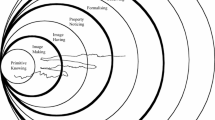Abstract
We describe the relationship that exists between shifts in engagement and shifts in mathematical thinking, using the construct of engagement structures. The engagement structure construct (Goldin et al. 2011) is a way to account for and describe the complex dynamical interactions that recur as students solve mathematical problems. Our research is focused on a group of eighth grade students solving a problem in a group setting in an urban district. Our analysis involves video-recorded episodes, retrospective interviews and comprehensive field notes. We also document the social conditions present in the classroom that surrounded the shifts. Our findings suggest a variety of changes that can occur within an individual student, and across students in the same classroom, depending upon the social context. At times, changes in mathematical ideas preceded shifts in engagement, and vice-versa. Aside from the within student differences, our research provides an example of how, within the same classroom, students can have very different engagement and mathematical experiences.
Access this chapter
Tax calculation will be finalised at checkout
Purchases are for personal use only
Similar content being viewed by others
Notes
- 1.
The problem was adapted from Exemplars K-12 (2004) www.exemplars.com
References
Csikszentmihalyi, M. (1990). Flow: The psychology of optimal experience. New York: Harper & Row.
English, L.D., Bergman Arleback J., & Mousoulides, N. (2016). Reflections on progress in mathematical modelling research. The second handbook of research on the psychology of mathematics education: The journey continues pp. 383–413.
Fredricks, J. A., Blumenfeld, P. C., & Paris, A. (2004). School engagement: Potential of the concept: State of the evidence. Review of Educational Research, 74, 59–119. https://doi.org/10.3102/00346543074001059.
Goldin, G. A. (2017). Motivating desires for classroom engagement in the learning of mathematics. In C. Andrà, D. Brunetto, E. Levenson, & P. Liljedahl (Eds.), Teaching and learning in maths classrooms (pp. 219–229). New York: Springer.
Goldin, G. A., Epstein, Y. M., Schorr, R. Y., & Warner, L. B. (2011). Beliefs and engagement structures: Behind the affective dimension of mathematical learning. ZDM – International Journal of Mathematics Education, 43, 547–560. https://doi.org/10.1007/s11858-011-0348-z.
Gómez-Chacón, I. M. (2011). Beliefs and strategies of identity in mathematical learning. In Roesken, B. & Casper, M. (Eds.), Current state of research on mathematical beliefs XVII: Proceedings of the MAVI-18 conference, September 2012, Helsinki, Finland (pp. 74–84).
Gómez-Chacón, I. M. (2017). Appraising emotion in mathematical knowledge: Reflections on methodology. In U. Xolocotzin (Ed.), Understanding emotions in mathematical thinking and learning (pp. 43–73). London: University of East Anglia.
Lesh, R., English, L. D., Sevis, S., & Riggs, C. (2013). Modeling as a means for making powerful ideas accessible to children at an early age. In S. Hegedus & J. Roschelle (Eds.), The SimCalc vision and contributions: Democratizing access to important mathematics (pp. 419–436). New York: Springer.
Middleton, J. A., & Jansen, A. (2011). Motivation matters, and interest counts: Fostering engagement in mathematics. Reston, VA: National Council of Teachers of Mathematics.
Middleton, J. A., Jansen, A., & Goldin, G. E. (2016). Motivation in Springer open Attitudes, beliefs, motivation and identity in math education: An overview of the field and future directions, ICME 13, Hamburg, Germany, pp. 17–26.
Middleton, J., Jansen, A., & Goldin, G. A. (2017). The complexities of mathematical engagement: Motivation, affect, and social interactions. In J. Cai (Ed.), Compendium for research in mathematics education (pp. 667–699). Reston, VA: National Council of Teachers of Mathematics.
Sanchez Leal, L., Schorr, R. Y., & Warner, L. B. (2013). Being challenged in an urban classroom: A case study documenting the engagement of a young male who wanted to “look smart”. Journal of Urban Learning, Teaching, and Research (JULTR), 9, 78–88.
Schorr, R. Y., & Koellner Clark, K. (2003). Using a modeling approach to consider the ways in which teachers consider new ways in which to teach mathematics. Journal of Mathematical Thinking and Learning: An International Journal, 5(2), 191–210.
Schorr, R. Y., & Lesh, R. (2003). A modeling approach to providing teacher development. In R. Lesh & H. Doerr (Eds.), Beyond constructivism: A models and modeling perspective on teaching, learning, and problem solving in mathematics education (pp. 141–157). Hillsdale, NJ: Lawrence Erlbaum.
Schorr, R. Y., Epstein, Y. M., Warner, L. B., & Arias, C. C. (2010a). Chapter 27: Don’t disrespect me: Affect in an urban math class. In R. Lesh, P. L. Galbraith, C. R. Haines, & A. Hurford (Eds.), Modeling students’ mathematical modeling competencies: ICTMA 13 (pp. 313–325). New York: Springer. https://doi.org/10.1007/978-1-4419-0561-1_27.
Schorr, R. Y., Epstein, Y. M., Warner, L. B., & Arias, C. C. (2010b). Mathematical truth and social consequences: The intersection of affect and cognition in a middle school classroom. Mediterranean Journal for Research in Mathematics Education, 9(1), 107–134.
Warner, L. B., Schorr, R.Y., & Goldin, G. A. (2018). Analyzing prospective teachers’ motivating desires during mathematical problem solving. In L. Gomez Chovam, A. Lopez Martino, & I. Candel Torres (Ed.), ICERI2018 Proceedings (pp. 10436–10441). IATED Academy. ISBN 978-84-09-05948-5.
Yakov M. Epstein, Roberta Y Schorr, Gerald Goldin, Lisa B. Warner, Cecilia C. Arias, Lina Sanchez-Leal, Margie Dunn & Tom Cain (2007). Studying the affective/social dimension of an inner-city mathematics class. Proceedings of the Twenty-Ninth Annual Meeting of the North American Chapter of the International Group for the Psychology of Mathematics Education, Lake Tahoe, NV, pp. 649–656.
Author information
Authors and Affiliations
Corresponding author
Editor information
Editors and Affiliations
Rights and permissions
Copyright information
© 2019 Springer Nature Switzerland AG
About this chapter
Cite this chapter
Warner, L.B., Schorr, R.Y. (2019). Chapter 4: Engagement Structures and the Development of Mathematical Ideas. In: Chamberlin, S.A., Sriraman, B. (eds) Affect in Mathematical Modeling. Advances in Mathematics Education. Springer, Cham. https://doi.org/10.1007/978-3-030-04432-9_5
Download citation
DOI: https://doi.org/10.1007/978-3-030-04432-9_5
Published:
Publisher Name: Springer, Cham
Print ISBN: 978-3-030-04431-2
Online ISBN: 978-3-030-04432-9
eBook Packages: EducationEducation (R0)




